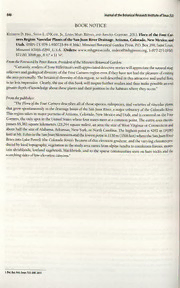
Preview BOOK NOTICE
BOOK NOTICE Kenneth Mary D. Heil, Steve L. O’Kane, Linda Reeves, and Arnold Clifford. 2013. Flora of the Four Jr., Cor- New ners Region: Vascular Plants of the San Juan River Drainage. Arizona, Colorado, Mexico, and Utah. (ISBN-13: 978-1-930723-84-9, hbk). Missouri Botanical Garden Box Press, P.O. 299, Saint Louis, Missouri 63166-0299, U.S.A. (Orders: www.mbgpress.info, [email protected], 1-877-271-1930). W. $72.00, 1098 pp„ 8 Vi" x 11 From the Foreword by Peter Raven, President of the Missouri Botanical Garden : Tony “Certainly, readers of Hillerman s well-appreciated detective stories will appreciate the natural mag- nificence and geological diversity of the Four Comers region even if they have not had the pleasure of visiting the area personally. The botanical diversity of this region, so well described in this attractive and useful flora, no is less impressive. Clearly, the use of this book will inspire further studies and thus make an possible ever greater depth of knowledge about these plants and their position in the habitats where they occur.” From the publisher: “The Flora Four Comers of the describes of those and all species, subspecies, varieties of vascular plants grow that spontaneously in the drainage basin of the San Juan River, a major tributary of the Colorado River. This region takes in major portions of Arizona, Colorado, New Mexico and Utah, and centered on the Four is Comers, the only spot in the United where common States four states meet at a point. The entire area encom- passes 65,382 square kilometers (25,244 square miles), an area the size of West Virginia or Connecticut and about half the size of Alabama, Arkansas, New m York, or North The Carolina. highest point 4292 (14,083 is m feet) at Mt. Eolus in the SanJuan Mountains and the lowest point is 1130 (3708 feet) where the SanJuan River flows into Lake Powell (the Colorado Because River). of this elevation gradient, and the varying climates pro- duced by local topography, vegetation in the study area varies from alpine tundra coniferous moun- to forests, tain shrublands, lowland sagebrush, blackbrush, and to the sparse communities seen on bare rocks and the scorching sides of low-elevation canyons.” Bot J. Res. Inst Texas 7(2): 840. 2013
